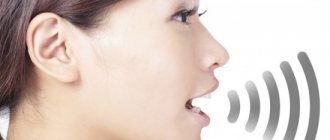The voice is a unique feature of a person, which makes it possible to communicate and live fully. However, hardly any of us in everyday life think about the importance of having a voice. This awareness comes only at the moment when problems with the voice appear or its complete loss. This process is called aphonia in medicine. There are many reasons for the occurrence of aphonia. Moreover, these can be completely unexpected processes, which at first glance are completely unrelated to the operation of the vocal apparatus. So, sore throat, lost voice - what to do? The main recommendation is immediate diagnosis in an ENT clinic. In this article we will look at the main examination methods for diseases of the vocal apparatus and methods of treating these problems.
Causes of aphonia
In order to understand why the voice may disappear, you need to know about the physiological processes of its formation. Voice is the sound vibrations that occur when air moves through closed vocal folds. When a person is silent, there is a small gap between the folds. For sound to be produced, the folds must be compressed. If this does not happen, we can talk about the manifestation of aphonia.
The ability to speak is affected by several pathological processes at once. The most harmless reason is colds, which, as a rule, do not cause much harm to the vocal cords. However, aphonia can also occur with other pathologies. Let's look at the main ones.
- Laryngitis in acute form (the cause of the inflammatory process of the larynx can be either simple hypothermia of the body or the action of harmful microorganisms. Depending on the causative agent of the disease, there are several types of laryngitis, which only an ear, nose and throat doctor . However, all of them can cause such as, for example, hoarseness of voice, and its complete loss - in especially advanced cases).
- Neck injuries (if this area is damaged, the vocal folds may be simultaneously injured, resulting in aphonia).
- Endocrine diseases (here we are talking primarily about the thyroid gland; the possibility of aphonia is due to the close location of the gland to the vocal apparatus).
- Foreign objects in the larynx area.
- Stress (against the background of emotional upheaval, hoarseness, hoarseness or complete loss of voice is a very common phenomenon).
- Excessive tension on the vocal cords (this is especially true for people in voice-speech professions, such as actors, singers, lecturers, and announcers).
- Neoplasms in the larynx (both malignant and benign tumors).
- Adolescence (this is the most harmless reason, since the process of voice change during puberty is in most cases the norm).
All of the above reasons for voice loss can manifest themselves either individually or in combination. The second option significantly complicates both the diagnosis and the course of the disease. At the same time, other unpleasant symptoms may occur: general weakness, pain and sore throat, loss of voice, fever.
Reasons why the voice disappears
The voice may not completely disappear (this is called dysphonia); more often we are faced with hoarseness or hoarseness. Complete aphonia with the ability to speak in a whisper is observed relatively rarely. Causes of this symptom:
- infection - most often voice changes occur with tonsillitis, pharyngitis, laryngitis;
- anomaly of the development of the larynx - in this case, dysphonia is detected during the neonatal period;
- allergies - swelling of the larynx and vocal cords;
- benign and malignant tumors of the larynx;
- myasthenia gravis;
- hormonal diseases;
- injuries (a long scream is also an injury);
- damage to the cranial nerves or their centers, etc.
In all these cases, the voice may become nasal, hoarse, quiet, hoarse, or completely disappear.
Diagnosis of voice loss
The most effective and modern diagnostic method for problems with the vocal apparatus is laryngoscopy, which can be done at the Lev Rudin clinic. The examination is carried out using special endoscopic equipment. Its essence is the introduction through the oral cavity of a tube with a micro-camera and a light device attached to the end. The image captured by the camera is displayed on the monitor and scaled. In this way, the doctor can assess the condition of the tissues and see the presence of inflammation or foreign objects.
This type of examination is as comfortable as possible for patients and is tolerated in almost 100% of cases without side effects such as a gag reflex or pain. For patients with increased sensitivity, local anesthesia is used to eliminate any discomfort.
, a phoniatrist in Moscow can also perform laryngoscopy using a stroboscope. Using the device, a beam of light is directed onto the vocal cords, the flashes of which are synchronized with the vibration of the cords. The device records the phonation process on video, which is then analyzed by a doctor. If the flashes of light and vocal vibrations were not identical, this indicates the presence of possible deviations in the operation of the vocal apparatus. In essence, this is a unique procedure that allows you to assess the condition of the ligaments and identify the cause of aphonia.
Both of the above procedures require preliminary preparation, since the tissues of the larynx are susceptible to easy damage. Before the diagnosis, the patient is prohibited from eating or drinking; violating this rule may cause vomiting. The day before the procedure, you are allowed to eat only light food in small quantities. Smokers should refrain from using tobacco.
You can read more about the laryngoscopy procedure and possible complications after it in a special section.
Ulezko Galina Mitrofanovna
Voice hygiene
phoniatrist G. M. Ulezko (Guidelines for persons of voice professions: vocalists, actors, teachers, lecturers, tour guides, kindergarten teachers, students, managers, etc.) The
guidelines set out the following issues: the concept of “voice” and its components; anatomy and physiology of the larynx; factors causing diseases and measures to prevent the most common diseases; voice hygiene during mutation, pregnancy, hazardous work, hormonal imbalances, diseases of the ENT organs, diseases of other organs and systems; smoking and alcohol as negative factors for voice function; vocal hygiene measures. For a wide range of readers.
Introduction.
Voice is the sound through which communication between living beings is possible. According to Academician Pavlov, this is the second signaling system that only humans possess. The voice is a means of communication; it can convey various subtle emotional experiences: joy, pain, fear, anger, delight, danger. Complex neural connections control vocal function, and disruption of this coordination leads to voice impairment. Thanks to the multiple shades of voice coloring, it can influence the nervous system of another person. This fact is used in the practice of psychotherapists as sound therapy.
Characteristics:
- I formant (2) - responsible for low frequencies in colloquial speech;
- Formant II (3) - responsible for high frequencies in colloquial speech;
- low singing formant (4) - responsible for low frequencies in the singing voice;
- high singing formant (HSF) (5) - III formant - is present only in the singing voice, gives the voice a special sonority, flight, “metal”, increases the strength of the voice, improves intonation, helps improve the quality of vibrato. The higher its vibration amplitude column on the spectrogram, the stronger and more beautiful such a voice is.
A voice devoid of high frequencies seems to the listener dull “as if from a barrel”, “creeping”, quieter, quickly fading, without ringing.
A voice lacking low frequencies has an irritating effect on the nervous system. The excessive predominance of high frequencies in it makes it shrill and unpleasant for the listener.
Individual harmonics (overtones) (6) - give a unique coloring of the voice, inherent only to a given individual. The richer the voice, the more overtones it has. From the data of the sound fund of the State Television and Radio Broadcasting Company (V.G. Ermolaev “Manual of Phoniatry”), the voice of E. Caruso, laid out on a spectrogram, had the highest frequency of vibration of the third formant and the richest set of individual harmonics.
So, a beautiful, healthy voice must have the full sum of characteristics in order to sound full and delight the ears of others. And the combination of different sound frequencies is expressed by the variety of sound colors.
Anatomy and physiology of the larynx.
The apparatus (instrument) with which a person produces sound (voice) is the larynx.
Structural elements of the larynx:
- True vocal folds (TGFs) - their thickness contains the vocal muscle. Vibrating under air pressure while inhaling, they produce sound. Their movements are controlled by the central nervous system (CNS). Using a microlaryngostroboscope (a device that allows you to see the movement of folds), their movements are determined in the form of flapping “butterfly wings”, oscillating in the horizontal and vertical planes. Normally, their surface is white, shiny, and the closure is complete.
- Vestibular (“false”) ligaments. They exist to compensate for the function of the IGS in case of injury (impossibility of movement due to paralysis, removal of one of the IGS in case of laryngeal cancer). When they close, the sound is lower, muffled and rougher than usual, and fatigue occurs quickly. With proper coordination of muscles and a healthy larynx, the false folds are motionless; with functional diseases of the larynx (nervous incoordination), a tendency to close may appear.
- Arytenoid cartilages. IGS are attached to their vocal processes. The processes work as “hinges”, perform various movements, through which the IGS move in different planes
- aryepiglottic fold
- The epiglottis is a protective device of the body that closes the entrance to the larynx during swallowing.
- Pear-shaped sinuses (pits) are depressions in the form of pockets.
- Anterior commissure (commissure) - corresponds to the anterior part of the true vocal folds.
- Interarytenoid space
- The ventricles of the larynx are a depression in the form of a gap between the true and false folds.
The voice apparatus is necessary for communication for any person, but for a professional, voice is an indicator of professional suitability. These individuals need a healthy apparatus, but they have a heavy vocal load.
Voice professionals.
Voice professionals include:
- singers;
- readers;
- actors;
- tour guides;
- agitators;
- kindergarten teachers;
- teachers and lecturers;
- lawyers;
- mass entertainers;
- radio and television announcers;
- persons holding leadership positions;
- dispatchers;
- telephone operators;
- students of theater and vocal educational institutions.
These persons, due to various factors, may suffer from certain diseases of the vocal apparatus, which do not allow them to engage in professional activities.
Let us analyze the harmful factors, having studied which, the measures of vocal hygiene and disease prevention are clear.
Kindergarten teachers.
They constantly have to sing and read against the background of noise created by children's voices, the spectral energy of which reaches 1000 Hz. To block out the noise, educators should raise their voices to 70-72 dB. During walks, the device is also significantly overstrained against the background of city noise.
Tour guides.
Large quantitative voice load. In some cases, noise, insufficient ventilation, increased dust content and the cooling factor are added. Employees of the city excursion bureau experience sudden changes in air temperature, noise from city transport, shocks, and the effects of gasoline vapors and gases on the respiratory tract. A malfunction or absence of a microphone on a bus increases the load on the vocal apparatus.
Teachers and speakers.
They have to daily overload the vocal apparatus with quantitative load and qualitative changes: they have to speak loudly, at very high notes, unusual for their voice. Along with this, the following are of great importance: temperature, air pollution (dust, chalk), the degree of relative humidity, maintaining the proper degree of silence in the classrooms, the acoustic properties of the room where classes and lectures take place.
Artists and students of theater universities.
Large speech load during rehearsals, performances, and stage classes. speech, the use of a wide range from quiet to very loud, imitation of animal voices, voices unusual for a given age (childhood, old age), transmission of emotional states (screaming, crying). This leads to the device operating under extreme conditions unusual for the normal speech mode of a person. Combination of voice work with various movements on stage; uncomfortable bulky costumes and props; stage dust; varnishes, paints and decorations have an adverse effect on the voice.
Vocalists - especially students of initial courses of vocal departments.
They are adversely affected by:
- Large daily vocal loads, previously unusual (contribute to overload);
- Using a solid attack, forced sound;
- Singing in a tessitura unusual for a given voice (both very high and very low);
- Singing without vibrato. Vibrato helps relieve muscle tension while holding a sound. A flat sound without vibrato accumulates static tension.
- Undeveloped vocal technique: singing without proper diaphragmatic-lower costal breathing, especially among vocalists who practice classical singing.
Incorrect change of chest and head registers, use of falsetto mode: a low-energy level in which only the edges of the vocal muscle work instead of the entire thickness of the muscle mass. When singing in this mode, rapid fatigue and non-closure in the form of an oval gap are observed, which is referred to in the literature as “vocal paresis”. Such a vocalist, if his technique is not perfected, will definitely have problems with his voice.Singing without proper breathing techniques leads to hypertonicity of the auxiliary muscles of the neck and upper chest and impaired closure of the ligaments.
- Rest is of great importance for the vocal muscle.
Full restoration of vocal function for a professional vocalist occurs after 6-12 hours of vocal rest (individually depending on the time of vocal load), a student of the vocal department needs more time for rest (individually depending on the onset of fatigue). Studies conducted to determine the time when signs of voice fatigue completely disappear suggest that after a performance, a rest of at least 24 hours is required for the soloist to fully restore his voice. A break between performances in large performances for leading soloists requires 3-4 days. - To prevent voice disorders, singing is prohibited during the menstrual cycle, when the IGS are swollen, they have a pronounced vascular network, and local blood circulation is increased.
Moreover, the first 2 days before menstruation are also dangerous for vocal breakdowns. When singing during such a period, there is a physiological rush of blood to the IGS, impaired mobility of the free edge due to some swelling. Therefore, there is a danger of non-closure, the occurrence of IGS nodules or even hemorrhage into the vocal muscle. In this regard, in opera houses and State Philharmonic Halls, the first three days of the menstrual cycle for singers are officially declared non-working days. But ideally, you should not sing for the entire period of your period. Due to the commercialization of creative activities and the signing of long-term contracts, rest becomes an impossible obstacle. Then the vocalist must carefully use breathing techniques, avoiding forced notes and selecting a repertoire that is easy for these days. As a last resort, follow the instructions of the phoniatrist on these days (sing “under the guise” of medications). But this is still a violation of vocal hygiene, which can lead to the formation of pathology.
To understand the pathology by people who do not have professional medical education, we can schematically divide diseases of the larynx into:
- Functional diseases of the larynx
- Organic diseases of the larynx: acute laryngitis
- chronic laryngitis
- benign laryngeal formations
- malignant tumors of the larynx
The most common diseases among voice professionals and the causes that cause them.
Functional voice disorders -
Associated with impaired coordination between the vocal folds and the central nervous system, with the inclusion of unnecessary auxiliary muscles of the neck and chest in phonation, and disconnection of the diaphragm from coordination (its spasticity).
The disorders are based on very complex neural mechanisms.
As a result, pathological movements of the IGS are observed:
- insufficient closure (hypotony);
- excessive convulsive closure (spasmodic dysphonia);
- sometimes there may be many complaints about voice fatigue during singing, but upon examination the picture of the larynx is normal (phonasthenia - exhaustion);
- there may be a complete loss of voice sonority, only whispered speech, the ligaments look normal, but close asynchronously, the picture changes all the time (functional aphonia);
These diseases are promoted by vocal and neuropsychic overload, stress, and non-compliance with the voice regime. For voice professionals: general fatigue, voice strain, forced singing, singing during menstruation, with acute diseases of the upper respiratory tract, weakening of the body as a result of a previous general illness. As a rule, it develops in individuals with an unstable nervous system. Failures among vocalists to sing certain notes (passages) cause fear of a new performance, thus increasing the nervous load.
Chronic laryngitis (inflammation of the larynx) -
In people of voice professions, it may be associated with repeated (frequent) respiratory diseases and work load during this period, as well as with a violation of the voice regime. Frequent overexertion causes persistent laryngitis. Untreated infection of neighboring ENT organs also maintains inflammation of the larynx.
Nodules of singers (screamers) -
Formations on the edges of the IGS occur due to vocal trauma (screaming, coughing), forced singing, singing during acute inflammatory diseases of the respiratory tract, during menstruation. Some patients note that with this pathology they cannot sing piano when they can sing forte well.
Hemorrhage into the vocal fold -
It can be either professional voices or any person. Typically this may result from:
- severe dry hysterical paroxysmal cough with a closed mouth, when subglottic pressure increases (often with tracheitis);
- as a result of a sharp forced squeal, scream;
- lifting weights;
- singing during menstruation;
- when singing during laryngitis, when the vascular network is especially pronounced.
Eliminating unfavorable factors in this case is vocal hygiene.
Other diseases of the larynx that occur in people of any profession.
Acute laryngitis -
Occurs with sudden hypothermia, acute viral infection, drinking cold drinks, after overheating, untimely treatment of upper respiratory tract diseases, staying in a room with a high concentration of chemical irritants. For the period of treatment, complete vocal rest and sick leave until complete recovery are recommended.
Malignant and benign formations of the larynx -
An important role is played by smoking cessation, compliance with the voice regime in patients with chronic laryngitis and timely treatment of chronic laryngitis.
Paresis or paralysis of the larynx (unilateral or bilateral) -
A serious voice pathology that requires thoughtful diagnosis and long-term painstaking correction.
It can be post-traumatic or of unclear etiology (cause).
- Post-traumatic paresis - after injuries (impact, hemorrhage) or operations on the neck (thyroid gland, blood vessels) or chest organs.
- Paresis of unknown cause can occur with cancer and other formations in the brain, larynx or nearby organs or chest organs. Any mechanical obstacle of a tumor or other nature (cysts, strokes, cerebral hemorrhages, heart disease, thoracic lymph nodes, etc.) can affect the center or periphery and disrupt the transmission of nerve impulses and cause difficulty in the mobility of the elements of the larynx
Vocal hygiene in this case is the timely identification and elimination of the main mechanical causes of the disease (no later than 6 months from the onset of complaints), as well as the rapid removal of postoperative swelling of the neck. It is also important not to be late with drug therapy and learn new voice skills in classes with a phonopedist, which will help you adapt to new conditions.
Mutational voice disorders.
Hygiene of a teenager's voice.
During puberty (for the voice, the period of restructuring is called mutation), there is a powerful release of hormones into the blood, changes in the blood circulation of organs and systems, growth of muscles and bones, and changes in the functioning of the endocrine glands. Before puberty, the vocal muscle was not yet formed; the mass of muscle fibers constantly grew in the thickness of the vocal fold over the years. During the period of mutation, the color of the muscle may change to pink due to a strong rush of blood, there may be non-closure, and marginal swelling. There may also be unchanged vocal folds.
The mutation period for each teenager occurs individually, depending on the growth rate of the body and the individual hormonal background. For the normal course of mutation, hardening procedures and sports are important in order to harmonize the restructuring of the body. Singing lessons should be differentiated: only with an experienced teacher who has experience working with children in mutation and clearly notes the period of onset of voice fatigue. For children with altered voice timbre, complaints about their voice and insufficient teacher experience, vocal lessons during the mutation period are not recommended. Dynamic control of mutation should be carried out by a phoniatrist as often as required by the teacher to assess the correctness of his classes.
The range of works must clearly correspond to the age and individual range of the child. Excessive tessitura can lead to voice disorders. Class time should be reduced because The voice gets tired quickly; during class there are several breaks of 3-5 minutes. The total time with breaks is no more than 40 minutes per day. Girls who have started their periods should be told that singing is contraindicated during this period. The mutation is associated with the fact that students in vocal departments are recruited from persons at least 18 years of age. During this period, the vocal muscle has already been formed, hormonal changes have been completed, and vocal endurance is high due to the youth of the body.
Voice hygiene in various industries.
There are groups of industries where inhalation of various substances negatively affects all mucous membranes, in particular the voice. Among them: miners, woodworking, metallurgy, textile, cotton processing industries, antibiotic production, agriculture.
Substances inhaled through the respiratory tract have an irritating, toxic, inflammatory, allergenic effect on the entire respiratory tract and on IGS. If fatigue, hoarseness occurs, or at the first complaints: examination in the occupational pathology department and cessation of contact with the harmful substance.
Vocal hygiene during pregnancy.
For vocalists during pregnancy, the individual voice can change in two ways: both improvement and the appearance of fatigue and hoarseness. This is due to a powerful change in hormonal levels, a change in the blood supply to the IGS. For vocalists who have no complaints, vocal training is allowed until the fetus begins to move. At a later stage, the fetus may experience oxygen starvation during singing, because exhalation during singing is long and a new portion of oxygen does not arrive immediately. But considering that with a well-developed technique of diaphragmatic breathing, air is consumed very sparingly, pregnant voice professionals can sing as long as they feel good, sometimes up to 9 months. As soon as general fatigue, sypota, and frequent fetal movements set in, classes should be stopped immediately. That. The approach during pregnancy is individual and if it progresses normally there are no restrictions. Reasonability and timely rest are important. The reference point is the well-being of the mother and fetus.
It is interesting that after childbirth, due to changes in the location and tone of the diaphragm, vocalists often observe a decrease in voice strength, unstable vocal breathing, difficulty singing staccato and legato, and “rapid loss of air” when singing. Over time, adaptations are formed to normalize the technique of diaphragmatic-lower costal breathing. This is physiological, for recovery you need to do special exercises (phonopedia) and smoothly move on to normal vocal loads only after the full return to the former vocal “form”.
Voice hygiene for hormonal imbalances.
Contraceptive contraceptives -
They can affect a change in voice timbre that was previously unusual for a given woman. The voice may become rougher, lower, or lose high frequencies. The use of these drugs by vocalists should be done with great caution. At the first appearance of symptoms, discontinue medications.
Thyroid diseases -
They lead to changes in the innervation and hormonal levels of the IGS, to their swelling, and changes in the amplitude of oscillations. Manifest in the form of fatigue, hoarseness of voice. In this case, it is necessary to adjust the dose of thyroid hormones by an endocrinologist. Without this, it is difficult to achieve the same sound of your voice.
Voice hygiene for diseases of the ENT organs -
A gentle voice mode is recommended. A voice professional with acute respiratory infections or acute tracheitis should be released from work for 3-5 days due to the fact that his vocal apparatus is not able to perform its functions at the appropriate level. For a lasting result, sanitation of foci of chronic infection of the ENT organs is mandatory.
Voice hygiene for diseases of other organs and systems -
A decrease in general tone and body resistance (asthenia) negatively affects the vocal apparatus. When singing, the body mobilizes, but gradually the strength decreases and the voice acts as an indicator of some disease: inharmonics appear, it becomes dull, weak, “lifeless,” “without energy.” Diseases of the gastrointestinal tract are unfavorable for the larynx. They cause subatrophic changes in the pharynx (insufficient functioning of the glands to produce protective mucus and associated dryness and soreness). The process gradually spreads into the larynx. This supports the voice disorder. Timely treatment of diseases of the gastrointestinal tract is the prevention of diseases of the vocal apparatus.
Smoking and vocal hygiene.
Nicotine has a local toxic, allergenic effect. In the form of microparticles, it is deposited on the IGS, loosens the mucous membrane, causes microerosions, swelling and disruption of the vibration of the free edge. The deep penetration of harmful microflora is facilitated, which is then difficult to get rid of. Therefore, smokers constantly maintain inflammation in the larynx. Due to the toxic effects of nicotine, the vascular network expands, which can lead to swelling and hemorrhages when coughing (all smokers experience chronic bronchitis). Long-term exposure to nicotine causes degeneration of the mucous membrane and contributes to the development of polyp-like changes and tumors of the larynx. It has an inhibitory effect on the central nervous system, supporting functional voice disorders. A healthy larynx and smoking are incompatible.
Alcohol and vocal hygiene.
Alcohol over 20 degrees creates a burn to the mucous membrane of the hypopharynx, disrupts the production of protective mucus by the glands, causing a local decrease in protection and ease of infection. In addition, it slows down the speed of nervous reactions and, with frequent use, can contribute to the development of dysphonia. The common belief among artists that a little cognac before a performance won’t hurt is deceptive. It gives results only in people with increased stage anxiety, relieving general muscle tension by inhibiting the nervous system. However, the overall concentration and tone of the vocal folds decreases. Therefore, you should not mindlessly follow this advice; it is better to look for other ways and turn to another type of stage setting for action.
Prevention of laryngeal diseases.
What matters is natural endurance, hardening, and the body’s ability to adapt to various changing environmental factors in any conditions. Some artists can sing in any situation, while others get sick under these conditions and are forced to undergo treatment for a long time. Observations of the condition of voice professionals have shown that those people who engage in physical exercise, do morning exercises, take water treatments, are able to relieve nervous system overstrain in a timely manner, are less exposed to the effects of colds and are less likely to suffer from diseases of the vocal apparatus.
Measures to prevent diseases of the larynx.
Hygiene is the science of measures to prevent various diseases.
Vocal hygiene is a group of activities aimed at preventing diseases of the vocal apparatus.
They include:
- Proper structure of vocal lessons, alternating periods of stress and rest.
- Correct vocal technique: timely switching of registers when singing; avoid using low-energy falsetto mode; be sure to sing with vibrato, achieve the technique of lower costal-diaphragmatic breathing, exclude the auxiliary muscles of the neck and chest from voice formation.
- Avoid forced sound, hard attack of sound, sharp forte, squealing, screaming.
- Prohibition of singing during menstruation.
- Singing during mutation only with an experienced teacher, active sports, hardening.
- Accurate determination of voice type, singing works characteristic of this type.
- Prohibition of vocal groups performing outdoors at temperatures below + 15 degrees. C, singing in the noise of city traffic.
- Avoid prolonged, monotonous speech, leading to the accumulation of static tension, and whispered speech.
- Stop smoking, moderate alcohol consumption.
- Eliminating, if possible, unwanted noise in the classroom during speech loads.
- Timely treatment of acute respiratory infections, tracheitis, release of voice professionals from work during this time.
- Work in clean rooms with sufficient humidity.
- Avoid contact with dust and harmful chemicals.
- Avoid sudden temperature changes and drinking cold drinks when overheated.
- Correct work with microphones for beginning singers and speakers who mistakenly abuse excessively loud phonation into the microphone. It is recommended to use the microphone in normal speech mode.
- General strengthening, hardening procedures.
- Timely treatment of ENT organs and other organs and systems, spa treatment, prevention of exacerbations.
- Attending classes and lectures of a phoniatrist (phonopedist) by persons of speech professions, mastering the skills of physiological use of the vocal apparatus, speech articulation, self-massage, autogenic training, receiving qualified explanation of the correct use of the voice.
General recommendations
Treatment of diseases that cause voice loss should be carried out strictly under the supervision of a medical professional. is also necessary , after which a diagnosis will be made and procedures and medications will be prescribed to alleviate the condition. At the first visit to the doctor, the patient should remember in detail what could have preceded the loss of voice. This could be hypothermia, a cold, severe strain on the vocal apparatus (for example, when singing or public speaking), or drinking too hot or cold drinks. The type of treatment will depend on the cause of the aphonia. However, in all cases it is worth adhering to general recommendations.
- Do not strain your vocal cords. If you have problems with your voice, you should only speak in a whisper. You should not try to pronounce words with a normal timbre, making an effort - overexertion will only aggravate the problem.
- Eat only soft foods. This is necessary in order not to damage the already inflamed tissue. Food and drinks must be at normal temperature.
- Stop smoking. Treatment of hoarseness in an adult without following this rule is almost impossible. Harmful substances released during smoking settle on the walls of the larynx and have a toxic effect on them, increasing the symptoms of aphonia.
- Maintain bed rest. This recommendation is especially relevant if the loss of voice is associated with a cold or laryngitis. If there is no accompanying symptom in the form of elevated temperature, hot foot baths will be useful. The presence of fever is a contraindication.
Do adults need this?
Speech muscles are the basis of our speech, the key to its quality, attractiveness, and the basis for the ability to exert influence with words. Few people want to listen to a person who has a lisp, burr or stutter. All these problems are in our mouths, and let such a literal statement not scare anyone. After all, a person who cannot speak fully and beautifully suffers from poor muscle development. For adults, this problem will become especially acute if the choice of profession falls on a teacher, announcer, actor, or marketer.
Dreams of becoming a successful leader will fade into oblivion if your speech is incoherent and unattractive.
Treatment methods for aphonia
The most common causes of voice problems are ARVI and influenza. In this case, no specific drugs are prescribed. The doctor focuses on eliminating the causes of colds - bacteria and viruses, after first examining the throat and larynx. You can read about the best drugs for ARVI in the article on the website: Effective drugs for ARVI - Pharmacotherapy for ARVI. As a rule, with general recovery, the voice is restored. If this does not happen, additional diagnostics are prescribed.
If aphonia occurs due to hormonal disorders in the thyroid gland, the ENT doctor will refer the patient for additional consultation with an endocrinologist. Eliminating hormonal imbalance will normalize the functioning of the vocal apparatus.
If there is a tumor in the throat and larynx, a concomitant symptom of which may also be loss of voice, the otolaryngologist will refer the patient for a consultation with an oncologist. Aphonia can also occur during a course of chemotherapy for malignant neoplasms, which is a symptom for reviewing the prescribed treatment.
When aphonia occurs in parallel with a lingering dry cough, bronchodilators may be prescribed. They relieve the symptoms of sore throat, eliminate dry throat and allow mucus to be removed, as a result of which vocal functions are also restored.
For swelling of the throat and accompanying aphonia, antihistamines (antiallergic) drugs, as well as inhalation procedures, are prescribed.
Emergency help is necessary if the voice suddenly disappears (this is especially true for children). Perhaps the cause was a foreign object entering the throat or larynx. Even if the foreign body was removed before the ambulance arrived, a doctor’s examination is necessary in any case, since internal tissues may be damaged.
to answer the question of what to do if your voice has disappeared , how to treat such a condition. Only a doctor can do this after conducting a full diagnosis and examining the test results. A laboratory where tests can be taken as quickly as possible is available in our clinic. You can familiarize yourself with the rules and prices in advance.
about how to prevent diseases that cause voice loss and what the concept of “vocal hygiene for a vocalist” in this article: Voice hygiene and prevention of dysphonia: TOP recommendations and advice for vocalists.
Treatments for hoarse voice in infants
In infants, the voice may become hoarse due to infection or prolonged crying. It is extremely undesirable to treat the infection on your own, since while it is not difficult to cope with an ordinary virus, then with diphtheria, in which the voice also changes, you cannot do without a doctor. The doctor will prescribe remedies for treating a hoarse voice in an infant.
Be prepared that it will not be possible to quickly restore a hoarse voice. With any form of the disease, it will take several days until it begins to return, and at first the voice will be rattling and then return to normal timbre.
The cause of a hoarse voice without signs of a cold should be determined by a doctor. Cancer or hormonal disorders cannot be easily detected, and the consequences can be extremely serious.
Related services: Consultation with a pediatric ENT specialist
Self-medication
Self-medication often leads to complications that may require surgery. Traditional medicine can only complement therapy aimed at suppressing the parasite. Along with this, the patient is prescribed a diet. It consists of eliminating foods from the diet that irritate the mucous membrane. This list can include all salty, peppery and spicy dishes that are served hot.
You can restore your voice in the absence of an inflammatory process on your own. Plant extracts that have a sedative effect (valerian solution or motherwort decoction) will help relieve nervous tension.
In case of vocal cord dysfunction, for example, after a football match, their rehabilitation will be facilitated by raspberry or blackberry juice and eggnog with the addition of a tablespoon of cognac. After taking them, it is recommended to remain silent so as not to strain the ligaments. Speaking in a whisper is not recommended, as this puts additional stress on the muscles of the larynx, which can only worsen the situation. If talking cannot be completely avoided, you should speak more slowly than usual. All words must be pronounced clearly.









